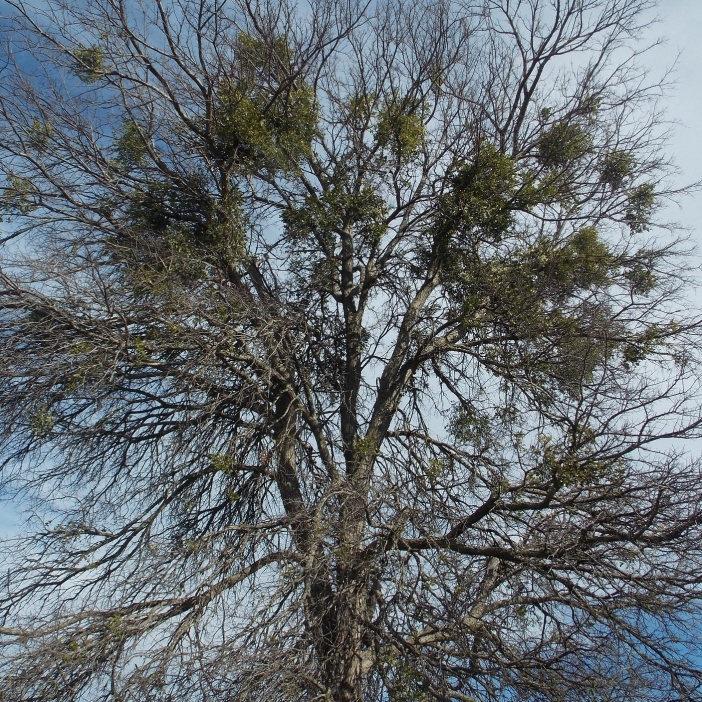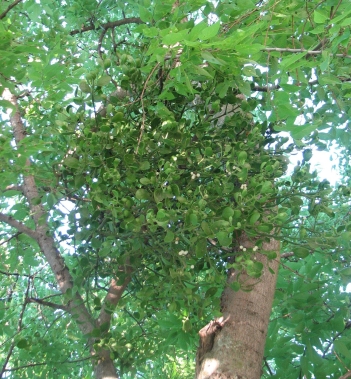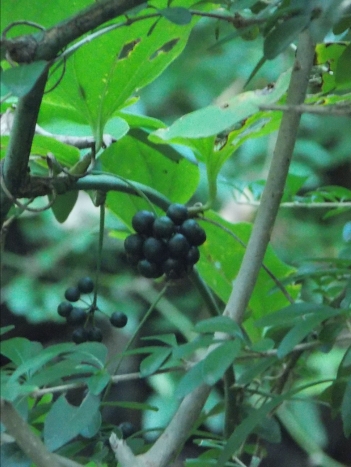Mesquite; Honey Mesquite Prosopis juliflora var. glandulosa Cockerell;. A variable, medium sized, drooping, deciduous tree with fine, leathery leaflets, Mesquite is the favored wood for barbecues, but a curse for ranchers. Mesquite drops long seed pods and thorny stems, disqualifying it as a lawn tree. However, the frond like pinnate leaves, composed of leathery, strap like leaflets arranged in opposite pairs, produce a pleasant, light shade. A short, sharp spine projects from each leaf node along the twigs. The deeply furrowed bark, dark when young, lightening with age, is heavy with tannin, staining the soil and any water it falls in. The wood is brittle and heavy, dark reddish-brown streaked with black, but rarely straight enough for lumber or furniture. It decays above ground, but is impervious to rot underground, so stumps do not rot out. Old trunks are invariably hollow, but continue to live, as long as live wood grows on the outer perimeter. The elongated fluffy, greenish white flowers are fragrant, but short lived, converting to long (4-9”), slightly flattened pods, with small flattened seeds. Amerind people ground and leached the beans to make a thick flour. The leaflets are nutritious and moist, and though protected by thorns, make excellent fodder. It is the first tree to colonize overgrazed range-land, so its range spread following over-grazing and the Dustbowl. Mesquite grow upright on long arching suckers, which continue to droop each year, till nearly prone. They are nearly impossible to eradicate, as they resist fire and sprout back from roots, but because the tree does not grow upright it is soon crowded out by oaks, juniper and elm. Mesquite prairies extend from Mexico to Oklahoma, dominating a belt that runs from Mexico through San Antonio, Stephenville and Vernon. Green wood is often burned in –BQ or grills, for it burns slow and produces steam, which keeps meat from drying out. Local lore claims that once mesquite blooms there is no longer danger of frost. The three named varieties, (glandulosa, velutina and torreyana) are difficult to distinguish. (515-516) 4/20/15 – 5/1/15; 4/25/16; 3/28/17- ; 4/15/18; 19 not recrd; 4/24/20;

Honey Mesquite habit; a sprawling tree with deeply furrowed, coarse bark, sharp spines, and leathery leaflets, bearing fluffy greenish white flowers which convert to light colored bean pods

Note; deeply furrowed, fibrous, grey bark is laced with tannins, staining water a dark red

Note; arching new growth slowly droops towards the ground till nearly prone

Note; pinnate, frond like leaves, composed of opposite pairs of strap-like, leathery, light green leaves
Note; long columnar spikes of flowers, made up of many tiny flowers, are lightly fragrant
Note; sharp spines at each leaf node along the twigs
Note; long been pods

































